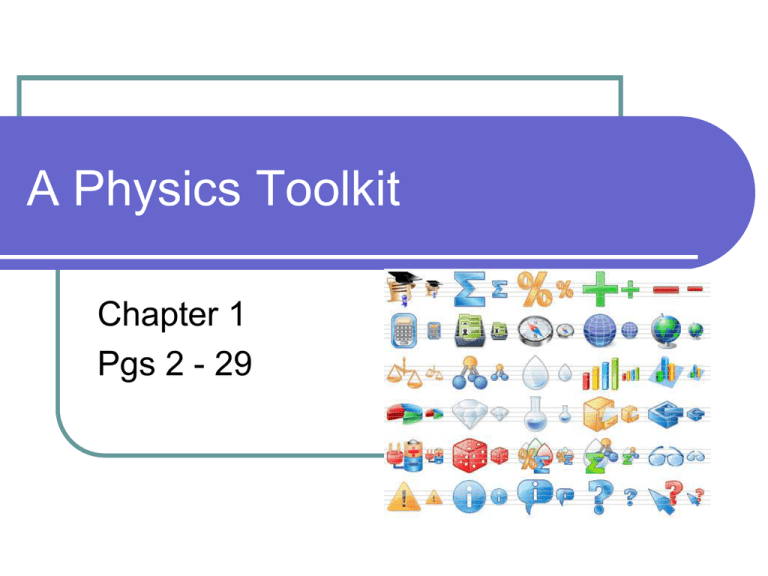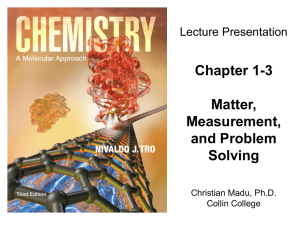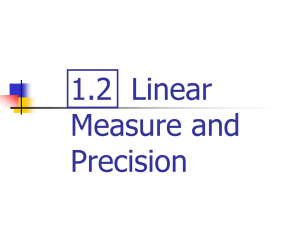A Physics Toolkit
advertisement

A Physics Toolkit Chapter 1 Pgs 2 - 29 Chapter Objectives Use mathematical tools to measure and predict. Apply accuracy and precision when measuring. Display and evaluate data graphically. Chapter 1. 1 Mathematics & Physics Demonstrate scientific methods. Use metric system. Evaluate answers using dimensional analysis. Chapter 1.1 Vocabulary Physics Dimensional analysis Scientific method Hypothesis Scientific law Scientific theory What is physics? Branch of science that involves the study of the physical world, energy, matter and how they are related What are some of the topics studied in physics? Do Now: What is the difference between Science and Technology ? Science: Scientia meaning knowledge Systematic way to build and organize knowledge in the form of testable explanations and predictions about the universe. Technology: application of knowledge is the making, modification, usage, and knowledge of tools, machines, techniques, crafts, systems, methods of organization, in order to solve a problem, improve a preexisting solution to a problem, achieve a goal or perform a specific function. Physics Electromagnetism Mechanics Kinematics Dynamics Static Electricity Current Optics Magnetism Light Mirrors Lenses Mathematics The language of Physics Why do you think mathematics is so important in physics? Equations: tool for modeling observations and for making predictions. SI: Système International d’Unités SI is based on the power of 10 SI has 7 base units We will concentrate on only the first three for now Page 5 in textbook SI Prefixes Only Need to know these 3 Page 6 in textbook Discussion: Why do scientists use the metric system, instead of the English or some other system? Why is it important to have an agreed upon system of units? Dimensional Analysis Every measured or calculated quantity is associated with a dimension Units used to express the dimension do not affect it Any equation must be dimensionally consistent Dimensional Analysis Method of treating units as algebraic quantities, which can be cancelled. Conversion Factor: is a multiplier that is equal to one Example: 1 kg = 1000 g Choose a conversion factor that will cancel the units May need to use more than one conversion factor Practice Convert 1 year into minutes. Do Now: Convert 1,000,000 seconds into days. Practice A car is moving at a speed of 90 km/h. What is the speed of the car in m/s? You are riding your bicycle down the hill at 15 m/s. What is your speed in km/h? Do Now: What is the scientific Method? Systematic method of observing, experimenting, and analyzing to answer questions about the natural world Scientific Method Scientific Method Hypothesis- educated guess about variables Must be testable Models Ideas, equations, structures, or systems used to describe a phenomenon Laws Rule of nature that sums up related observations to describe a pattern in nature Theories Explanation based on many observations supported by experimental results Do Now: Complete the following conversions using Dimensional Analysis 120 km/h into mph 120 km/h into m/s 65 mph into km/h 65 mph into m/s Conversion Factor 1 mile = 1.610 km • • • • 74.5 mph 33.3 m/s 104.7 km/h 29.1 m/s Chapter 1.2 Measurement Distinguish between accuracy and precision Chapter 1.2 Vocabulary Measurement Precision Accuracy Measurements Comparison between an unknown quantity and a standard NIST- National Institute of Standards and Technology CGPM – General Conference on Weights and Measures NIST-F1 Cesium Fountain Atomic Clock The Primary Time and Frequency Standard for the United States Measurement of elapsed time consists of counting the repetitions of any phenomenon that repeats itself as a measure of time 1967 – CGPM adopted a definition of a second based on a characteristic frequency of the radiation emitted by a cesium atom Standard of Length Meter Length of the path traveled by light in vacuum during a time interval of 1/299,792,458 seconds Standard of Mass : Prototype Kilogram No. 20 Think, Pair, Share How would you criticize the statement: “one you have picked a standard, by the very meaning of ‘standard’ it is invariable”? Accuracy vs. Precision Accuracy Precision Describes how well the The degree of results of a exactness of a measurement agree measurement with the “real” or accepted value Precision Millimeter Centimeter What is the measurement at the red line in meter, centimeters, and millimeters? What determines the precision of a measurement? How does the last digit differ from the other digits in a measurement? Precision & Significant Figures Increasing the precision of measurements decreases the experimental uncertainty When reporting data, make sure to use correct significant figures as to accurately represent the precision used in making the measurements Chapter 1.3 Graphing Data Graph the relationship between independent and dependent variables Interpret graphs Recognize common relationships in graphs Do Now: What is the purpose of collecting data during a lab? Chapter 1.3 Vocabulary Independent Variable Dependent Variable Line of best fit Linear relationship Quadratic relationship Inverse relationship Experimental Design Purpose? Determine relationship between two different variables Controlled Experiments Manipulate only one variable in an experiment Observe its effect on a second variable Hold ALL other variables in the experiment CONSTANT Variables Any factor that might affect the behavior of an experimental setup. Independent Variables Factor that is changed or manipulated during the experiments Always plotted on the x-axis Time is usually the independent variable Dependent Variables Factor that depends on the independent variable Always plotted on the y-axis Recording Data Raw data is recorded (ink) on a data table immediately as it is collected in the lab. Data Table Independent variable in leftmost column of the data table Every column is labeled with the name of the variable being measured with the units in parentheses below the variable name. Values in table do not have units. Same number of decimal places in each column Construct data table before collecting the data Preparing the Data Raw data might have to be “prepared” before graphing If multiple trials were done, average the trials together to determine a representative value. An entry in your formal table that is a result of a calculation must include an explanation of the column and a SAMPLE CALCULATION Graphing Data Purpose Determine the relationship between the two variables Usually scatter graphs Graphs Title: DEPENDENT VARIABLE vs. INDEPENDENT VARIABLE Scaled Axis: labeled with the QUANTITY and the UNITS Line of best fit: shows overall tendency Graphical Analysis Four Basic Relationships No relation Linear Relations (Direct Relationship) Square Relations Inverse Relations Develop mathematical model Equation No Relation Changing the independent variable has NO effect on the dependent variable. The dependent variable stays the same Graph is a horizontal line Slope = 0 Equation: y = constant Linear Relations Graph forms a straight line with a nonzero slope Equation: y = mx + b m is the slope of the line Can be positive or negative b is the y-intercept Direct Relations A special linear relationship As one factor increases by a certain factor, the other variable must also increase by the same factor MUST go through the origin of the axes Y-intercept: b = 0 Must have data point (0,0) Square Relations Non-Linear Parabolic or Quadratic Top/bottom opening parabolas Equation: y = ax2 + bx + c If vertex is at the origin (0,0), then y = ax2 Side opening parabolas Linearize the graph to determine whether or not the graph is truly a parabola Inverse Relations As the independent variable increases the dependent variable decreases Equation y = a/x Linearizing Graphs Manipulate the data according to the relation you think it might be If you have predicted the right relation and manipulate it accordingly, it will result in a linear graph Test Plot: graph made with mathematically manipulated data for the purpose of testing whether or not our guess about a mathematical relation might hold true •Dependent Variable •Graph •Hypothesis •Mathematical Model Experiment •Measurement Independent Variable Spaghetti Bridge: Formal Lab Report Objective: to measure the strength of spaghetti by using it to make a bridge across two tables. Questions: 1. What are the possible variables that you can have in building a spaghetti bridge? 2. What two variables are you going to be looking at to find a relationship? 3. Identify your variables listed in number 1 as either independent variables, dependent variables, or controls. 4. Write a hypothesis. 5. What are the materials that you will be using? 6. Write a procedure to test your hypothesis. Remember that you need to collect measurable data. You need 5 data points and 3 trials for each data point. 7. Draw your data table. 8. When done, show to Mrs. Faria to get your materials. Post Lab Questions: 1.Create a graph (dependent variable vs independent variable) 2.Draw a line of best fit. 3.What relationship do you see between the two variables. 4.Write an equation that best fits your line. 5.What is the physical meaning of the slope of your line. Lab Questions 1. (6) What are the possible variables that you can have in building a spaghetti bridge? Identify each variable as independent, dependent, or as a control. 2. (5) Create a graph (dependent variable vs independent variable) 3. (2) Draw a line of best fit. 4. (2) What relationship do you see between the two variables. 5. (2) Write an equation that best fits your line. 6. (3) What is the physical meaning of the slope of your line. If it is not a line, then describe what the graph is showing. Spaghetti Lab Points Format 2 pts Objective 1 pt Hypothesis 1 pt Materials 1 pt Procedure 5 pts Data Table 5 pts Questions 20 pts Practice Problems 5, 6, 7, 8, 13, 17, 18, 21, 23, 24, 26, 37, 39, 40, 43, 45, 46, 57, 61, 67, 69, 84, 85, 89







